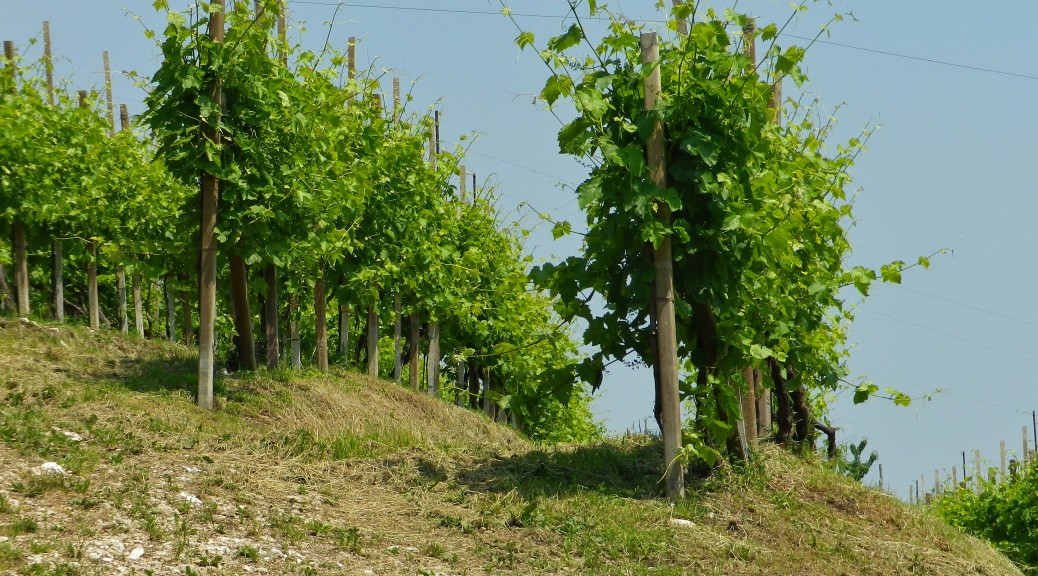What I Learned
The production area for Prosecco DOC wines maybe be found throughout northeastern Italy in the provinces of Belluno, Pordenone, Treviso, Padua, Gorizia, Udine, Venice and Vicenza. However, two major production districts within the Veneto region, in the Province of Treviso, are particularly well-known: Conegliano and Valdobbiadene (stress on the second “A”, in case you wondered). This is the designated Prosecco DOCG area, a higher quality level than the Prosecco DOC. Conegliano anchors the eastern part of the area. Valdobbiadene is located in the western part of the area. Wines from there may carry the Valdobbiadene Prosecco Superiore, DOCG label if they meet the higher quality standard regulations. The wines in this post focus on the Valdobbiadene district of the Veneto’s “Prosecco” region.
Creating bubbles requires one of four different production methods. The traditional (also known as the classic or Champenoise) method requires that sugar and yeast are added to a bottle of wine, which then undergoes a second fermentation, producing all those lovely bubbles. This is not the method used here. Vintners here produce Prosecco using the Charmat production method. This means that the second fermentation of the wine occurs in large tanks, not in bottles. The yeast is then clarified, and the wine is then bottled under pressure.
The most important varietal in Prosecco wines is the Glera. Formerly known as the Prosecco varietal, it was re-designated “Glera” in 2009. Now the word Prosecco refers only to the wine. The grape itself though was well-known in antiquity.
Vintners may add up to 15 per cent total of other varietals in a Prosecco cuvee. These include Verdiso, Chardonnay, Pinot Grigio, Pinot Bianco and Bianchetta Trevigiana.
Verdiso is an indigenous white grape. Vintners use it not only in Prosecco cuvees, but also to make the sweet, passito wines of Torchiato di Fregone (just to the north of this area), and as a still or sparkling varietal wine. Qualifying wines from Verdiso grapes may bear the Verdiso IGT (Indicazione Geografica Tipica) label. Verdiso wines can be rather difficult to find even within the region, but the village of Combai di Miane is a regional producer and promoter of it.
What I Tasted
2014 Prosecco Brut, Cru Crede, Valdobbiadene Prosecco Superiore, DOCG, Azienda Bisol : A dry, white sparkling wine cru (Glera, Verdiso and Pinot Bianco) with light gold color and fine, lively, swirling bubbles; floral, bread and mineral notes on the nose; bread and red apple flavors; creamy mouthfeel and medium acidity.
2014 Glera, Spumante, Extra Dry, Cantina Ruggeri (Valdobbiadene): An off-dry white sparkling wine with pale gold color, and fine bubbles; slight floral nose, with bread, white floral and red apple flavors; creamy mouthfeel, and medium-high acidity.
Prosecco Brut, Cima, Valdobbiadene Prosecco Superiore, DOCG (bottled by Cantina Sociale di Tezze del Piave): A dry white sparkling wine with medium-light gold color and fine lively bubbles; a bready, mineral and floral nose, with green apple and floral flavors; creamy mouthfeel with medium-high acidity.
Prosecco Brut, Vigneto della Riva di San Floriano, Valdobbiadene Prosecco Superiore, DOCG, Nino Franco (Valdobbiadene): A dry, white sparkling wine with a light medium gold color and very lively, fine, swirling bubbles; a bread and mineral nose, and toast, mineral and slight floral flavors; medium acidity with a tart finish.
